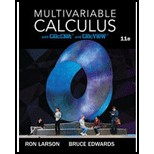
Deriving a Sum Derive Euler’s famous result that was mentioned in Section 9.3,
(a) Prove that
(b) Prove that
(c) Prove that
(d) Prove the
(e) Prove that
(f) Use the formula for the sum of an infinite geometric series to verify that
(g) Use the change of variables
Want to see the full answer?
Check out a sample textbook solution
Chapter 14 Solutions
Student Solutions Manual For Larson/edwards? Multivariable Calculus, 11th
- Find the exact area inside r=2sin(2\theta ) and outside r=\sqrt(3)arrow_forwardA 20 foot ladder rests on level ground; its head (top) is against a vertical wall. The bottom of the ladder begins by being 12 feet from the wall but begins moving away at the rate of 0.1 feet per second. At what rate is the top of the ladder slipping down the wall? You may use a calculator.arrow_forwardExplain the focus and reasons for establishment of 12.4.1(root test) and 12.4.2(ratio test)arrow_forward
- Use 12.4.2 to determine whether the infinite series on the right side of equation 12.6.5, 12.6.6 and 12.6.7 converges for every real number x.arrow_forwarduse Cauchy Mean-Value Theorem to derive Corollary 12.6.2, and then derive 12.6.3arrow_forwardExplain the focus and reasons for establishment of 12.5.4arrow_forward
- Algebra & Trigonometry with Analytic GeometryAlgebraISBN:9781133382119Author:SwokowskiPublisher:Cengage
